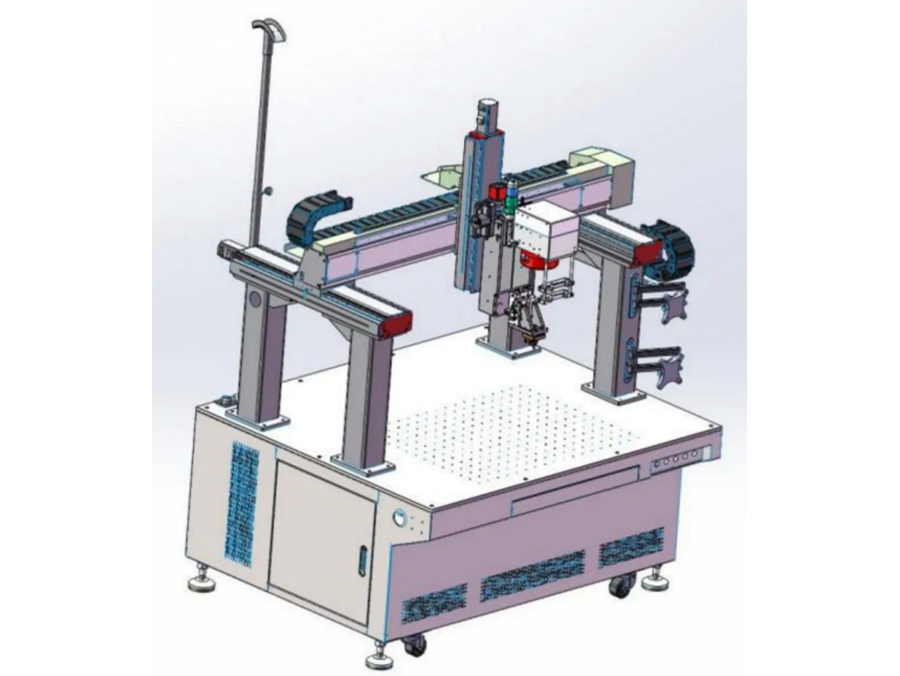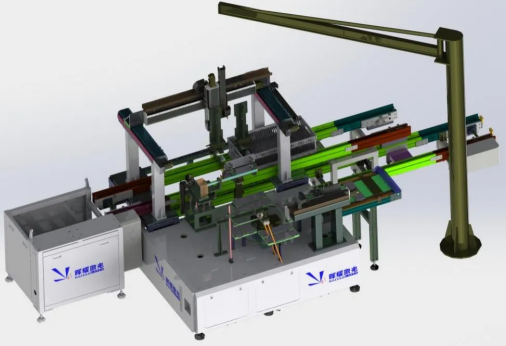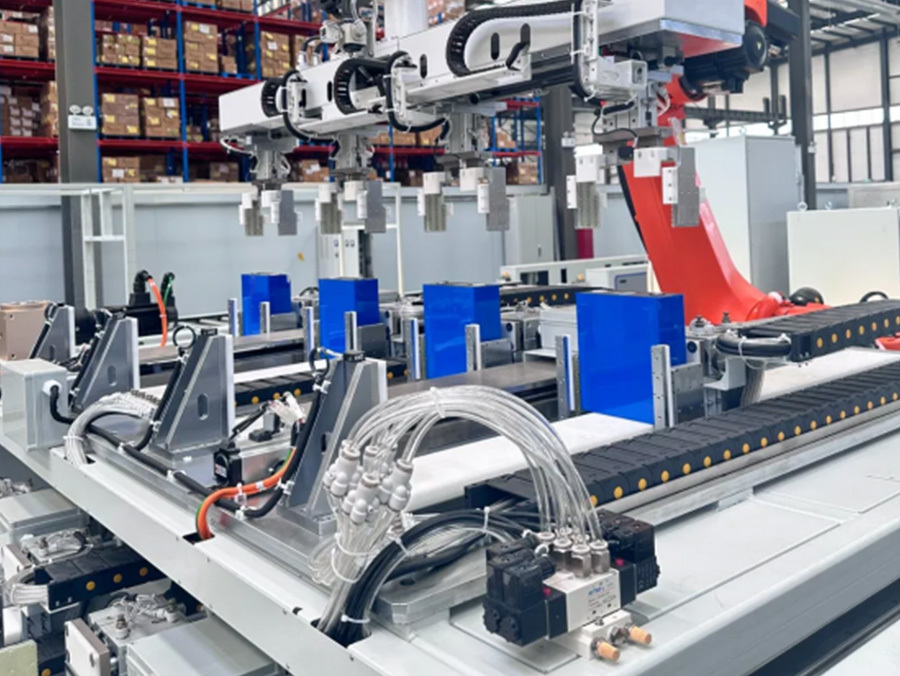Solution

EV Cylindrical Battery Module PACK Assembly Line
- Product description
-
- Commodity name: EV Cylindrical Battery Module PACK Assembly Line
- Commodity ID: 3.2动力大圆柱电池模组PACK线
The EV Cylindrical Battery Module PACK Assembly Line is a fully automated production system designed for efficient assembly of cylindrical cells into battery modules and packs.
1. Equipment Overview
The EV Cylindrical Battery Module PACK Assembly Line is a fully automated production system designed for efficient assembly of cylindrical cells into battery modules and packs. It incorporates cell sorting, grouping, module assembly, electrical interconnection, testing, and PACK assembly to ensure high precision, traceability, and reliability. This line is optimized for EV applications with flexible configurations and integrated quality assurance systems.
2. Key Features
- High Throughput: Fully automated line ensures consistent production efficiency.
- Flexibility: Supports various cylindrical cell sizes (e.g., 18650, 21700, 4680).
- Precision Welding: Advanced laser welding for interconnect reliability.
- Quality Assurance: Inline testing and inspection at multiple stages.
- Smart Integration: MES system compatibility for real-time data and process control.
3. Technical Specifications
3.1 Cell Sorting and Grouping
- Sorting Accuracy:
- Voltage: ±0.01 V.
- Capacity: ±0.1 Ah.
- Internal Resistance: ±0.1 mΩ.
- Sorting Capacity: Up to 1,200 cells/hour.
- Grouping Strategy: Automatic grouping by voltage, capacity, and resistance for balanced modules.
3.2 Module Assembly
- Cell Arrangement: Supports various configurations, including parallel and series arrangements.
- Fixture Accuracy: ±0.2 mm alignment for cylindrical cells.
- Adhesive Application: Automated dispensing of thermal adhesive for structural integrity and heat dissipation.
- Cycle Time: ≤40 seconds/module.
3.3 Electrical Interconnection
- Connection Method:
- Laser welding for busbar connections.
- Optional ultrasonic welding for tab-to-tab connections.
- Welding Precision: ±0.1 mm.
- Busbar Material: Nickel or copper with optional conductive coatings.
- Conductivity: ≤0.2 mΩ per connection.
3.4 PACK Assembly
- PACK Design:
- Customizable configurations for EV applications (e.g., 8s1p, 16s2p, etc.).
- Casing Assembly: Automatic alignment and fastening of PACK enclosures.
- Thermal Management Integration:
- Liquid cooling plates or air-cooling channels added during assembly.
3.5 Integrated Testing and Inspection
- Inline Testing:
- Voltage, current, and internal resistance measurement.
- Welding strength verification.
- High-Pot Testing:
- Voltage Range: 0–1,000 V DC.
- Insulation Resistance: 0.1 MΩ–1 GΩ, ±1%.
- Leakage Testing: Air tightness check with sensitivity of 1 × 10⁻³ Pa·m³/s.
- Visual Inspection: Camera-based inspection for welding and assembly defects.
3.6 Automation and Control
- Control System: PLC-based with integrated HMI for real-time monitoring and operation.
- Data Management: MES integration for production tracking and traceability.
- Alarm System: Automated fault detection with alerts for process deviations.
- Programmable Recipes: Supports multiple product configurations with minimal changeover time.
3.7 Line Capacity and Efficiency
- Production Rate: Up to 200 modules/day or 100 PACKs/day (depending on configuration).
- Uptime Efficiency: ≥98%.
- Changeover Time: ≤20 minutes for different configurations.
3.8 Safety Features
- Emergency Stop: Strategically placed emergency stop buttons.
- Laser Safety: Enclosed laser stations with Class 1 safety compliance.
- High-Voltage Safety: Insulated workstations and automated power cut-off during testing.
- Certifications: CE, UL, ISO 9001, ISO 14001 compliant.
3.9 Mechanical Design
- Line Layout: Modular, customizable layout ranging from 30–80 meters.
- Material Handling: Conveyor system with anti-static trays.
- System Weight: 8,000–20,000 kg depending on configuration.
3.10 Environmental Requirements
- Operating Temperature: 15–35°C.
- Humidity: ≤60% RH (non-condensing).
- Power Supply: AC 380V ±10%, 50/60 Hz, 3-phase.
- Power Consumption: ≤120 kW.
4. Applications
- Electric Vehicles: Cylindrical battery module and PACK assembly for EV powertrains.
- Energy Storage: Modules for renewable energy storage systems.
- Industrial Applications: Battery PACKs for robotics, backup power, and industrial automation.
5. Maintenance and Warranty
- Maintenance Schedule:
- Weekly: Inspection and cleaning of key components.
- Monthly: Calibration of measurement tools and welding equipment.
- Annually: Comprehensive diagnostics and software updates.
- Warranty:
- Standard: 1 year.
- Extended: Customizable based on service agreement.
Key words:
EV Cylindrical Battery Module PACK Assembly Line
Series of Products
Huiyao Laser is a leading battery laser welding machine manufacturer offering professional battery pack and battery module welding solutions for many fields, such as energy storage systems of research and development machines, as well as complete assembly lines for module and battery pack production.
Comprehensive Pouch Battery Module PACK Automatic Production Line for Efficient Output 12PPM is designed for the modular production of solid-state batteries, featuring high automation, flexibility, and integrated quality control (QC) systems. It ensures efficient production while maintaining strict quality standards. The line is suitable for electric vehicles, energy storage systems, consumer electronics, and more, supporting the production of various specifications of solid-state battery modules.
Comprehensive Pouch Battery Module PACK Automatic Production Line for Efficient Output 12PPM is designed for the modular production of solid-state batteries, featuring high automation, flexibility, and integrated quality control (QC) systems. It ensures efficient production while maintaining strict quality standards. The line is suitable for electric vehicles, energy storage systems, consumer electronics, and more, supporting the production of various specifications of solid-state battery modules.
Huiyao Laser Fully-Automated Energy Storage Prismatic Battery Module PACK Line
Huiyao Laser Energy Storage Automatic Prismatic Battery Module PACK Line is an efficient, intelligent and customized automated production line, specifically designed for the energy storage field. It is suitable for application scenarios such as large - scale energy storage systems, home energy storage, and industrial energy storage. This production line integrates advanced laser welding technology, automated assembly systems, and intelligent detection equipment, aiming to provide customers with the production of battery modules with high consistency and high reliability.
Get a Free Quote
PLEASE LEAVE YOUR MESSAGE AND WE WILL CONTACT YOU AS SOON AS WE RECEIVE IT!
FAQ
Q
How do you ensure consistent weld quality in the assembly of Prismatic battery packs?
A
Q
What are the best practices for cell alignment and stacking in a Prismatic battery PACK assembly?
A
Copyright © Huiyao Laser Technology (Luoyang) Co., Ltd. Has supported ipv6




